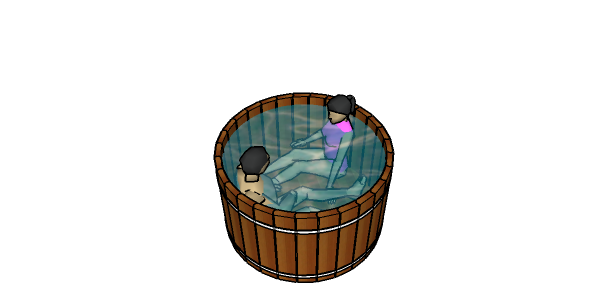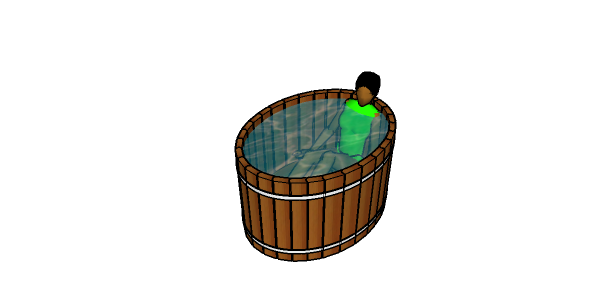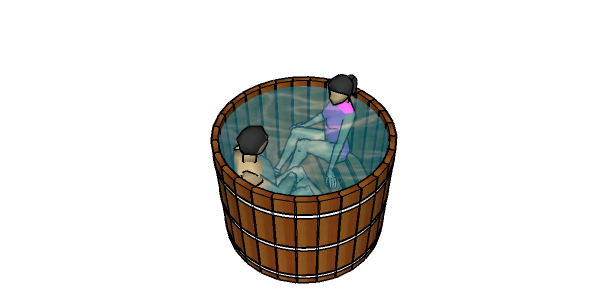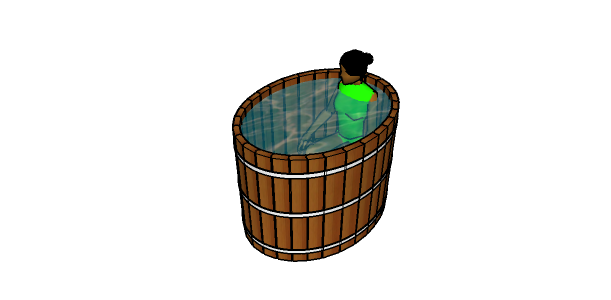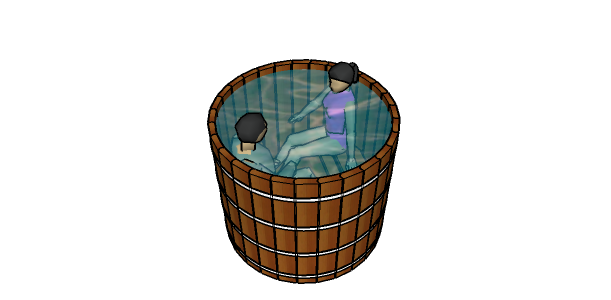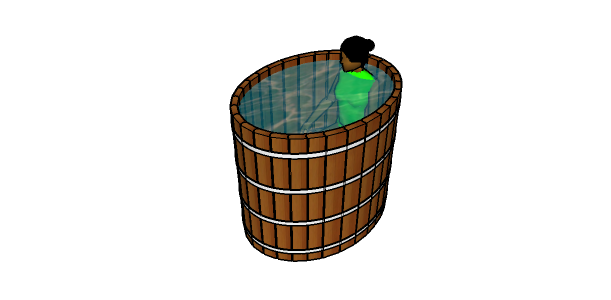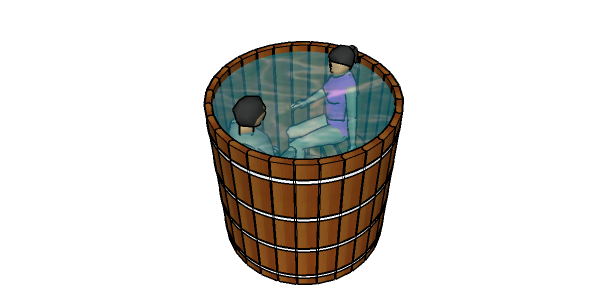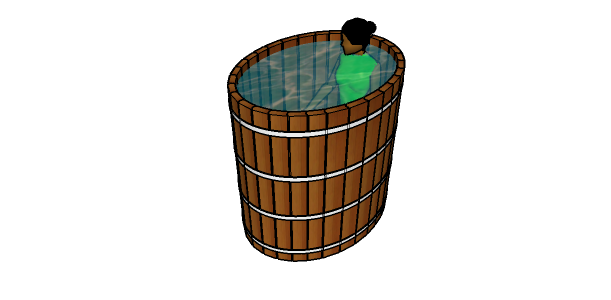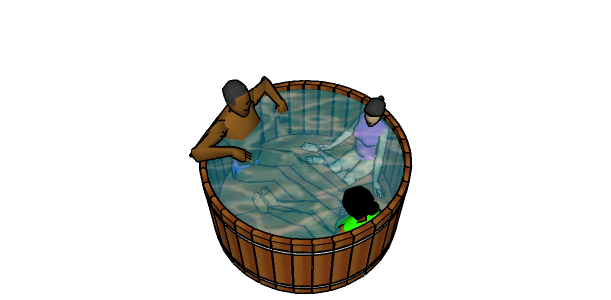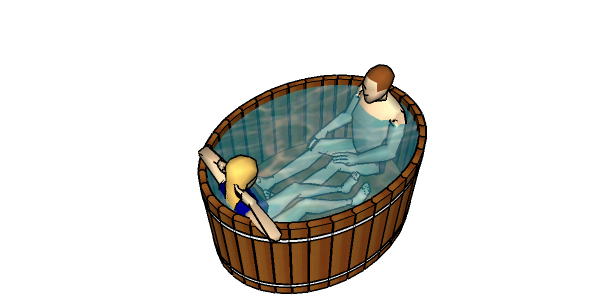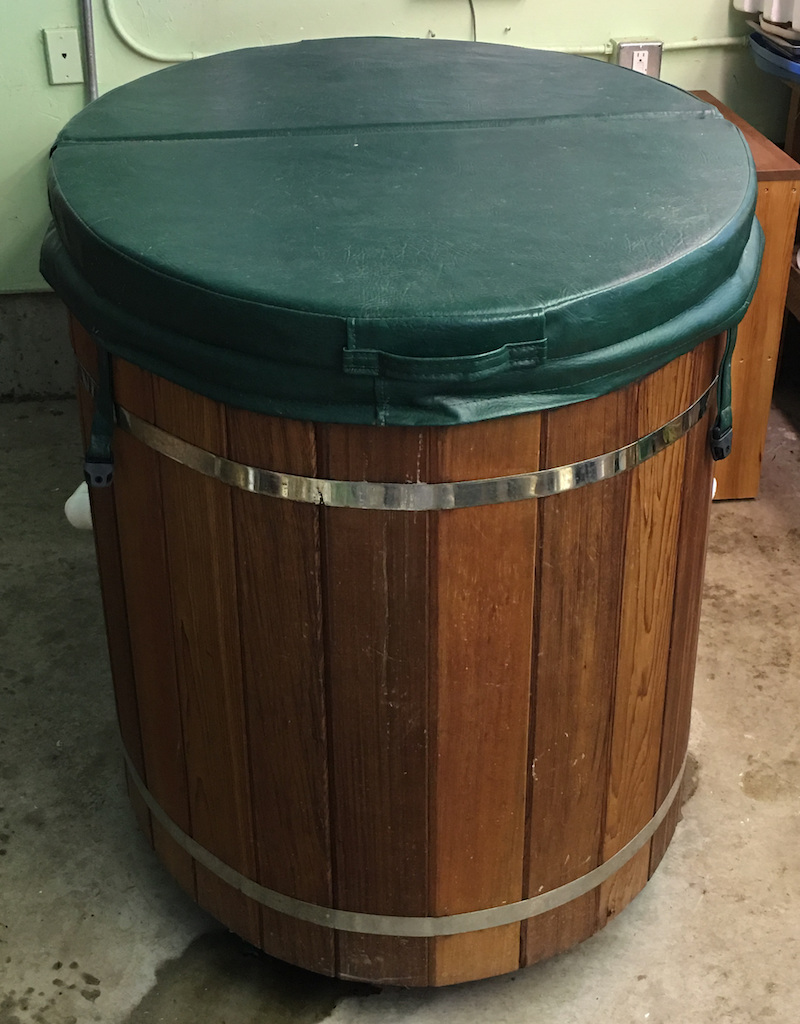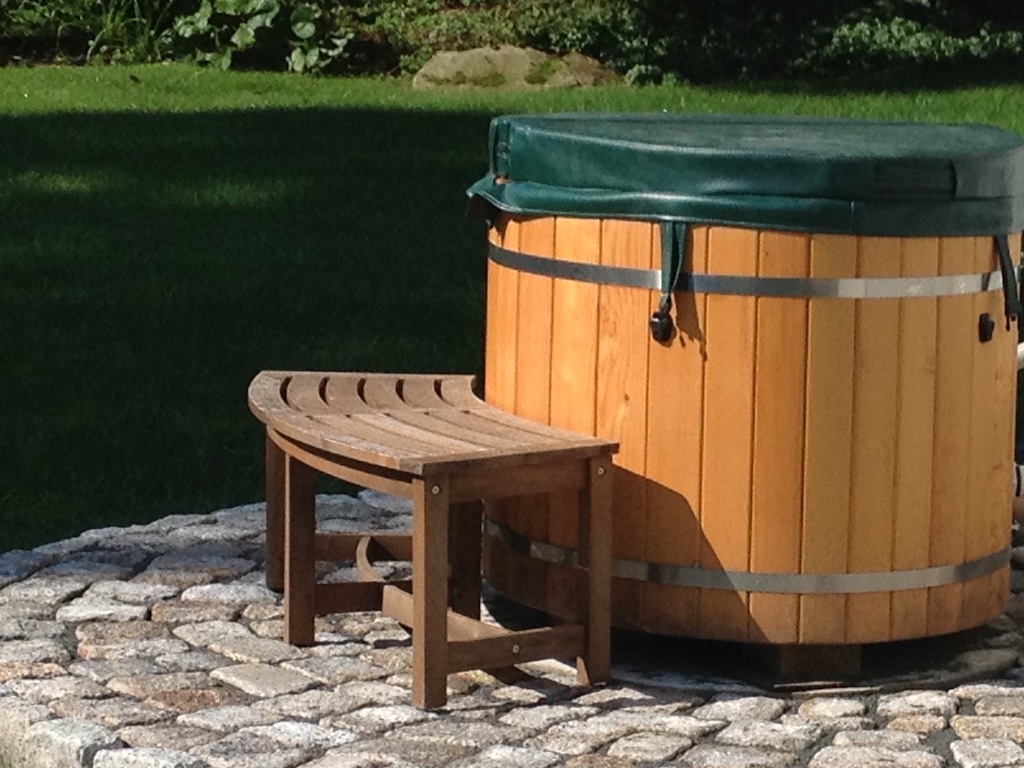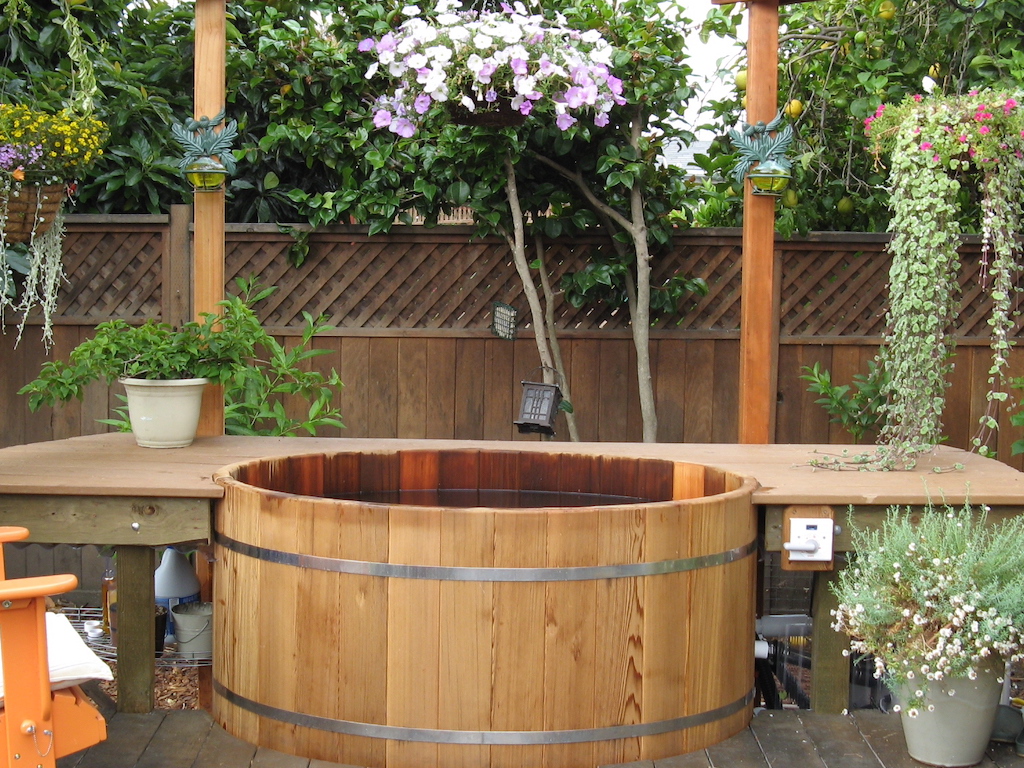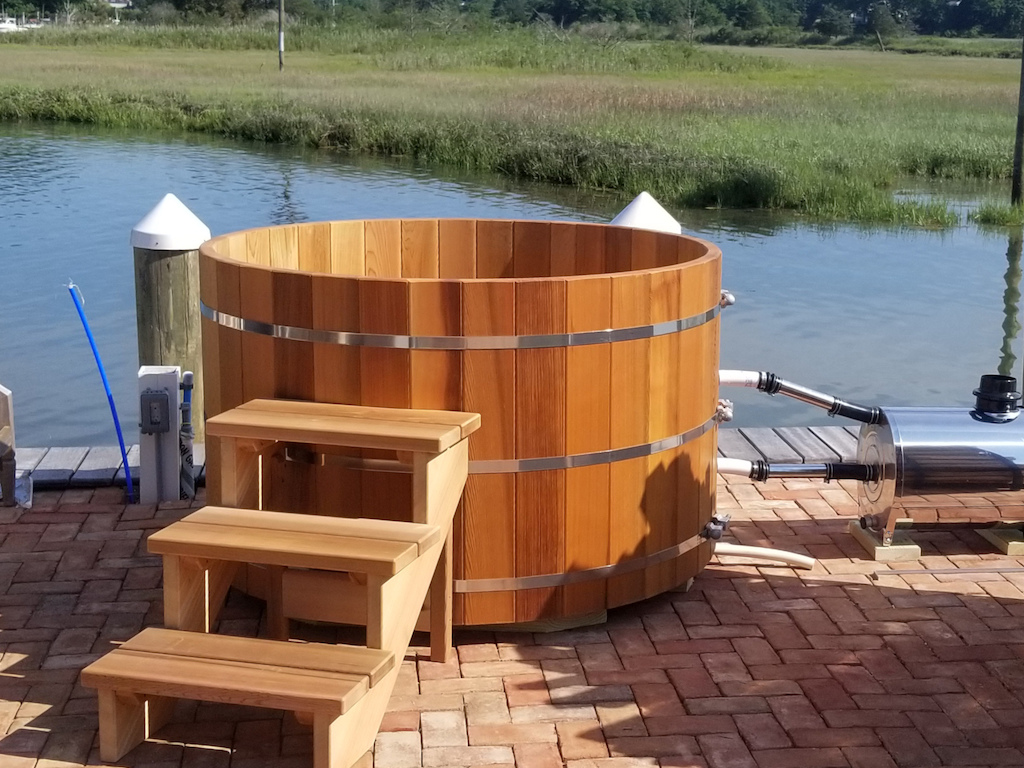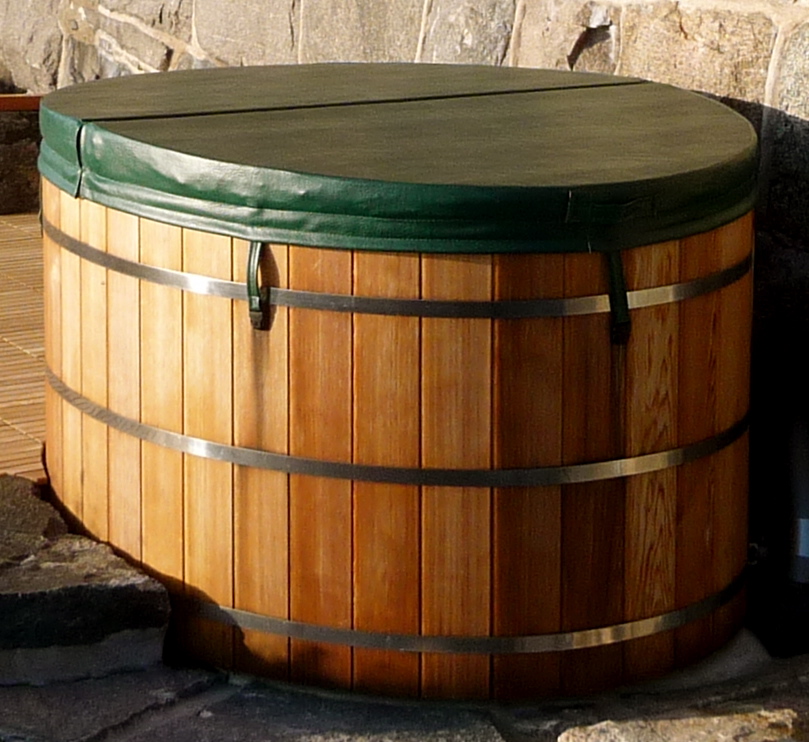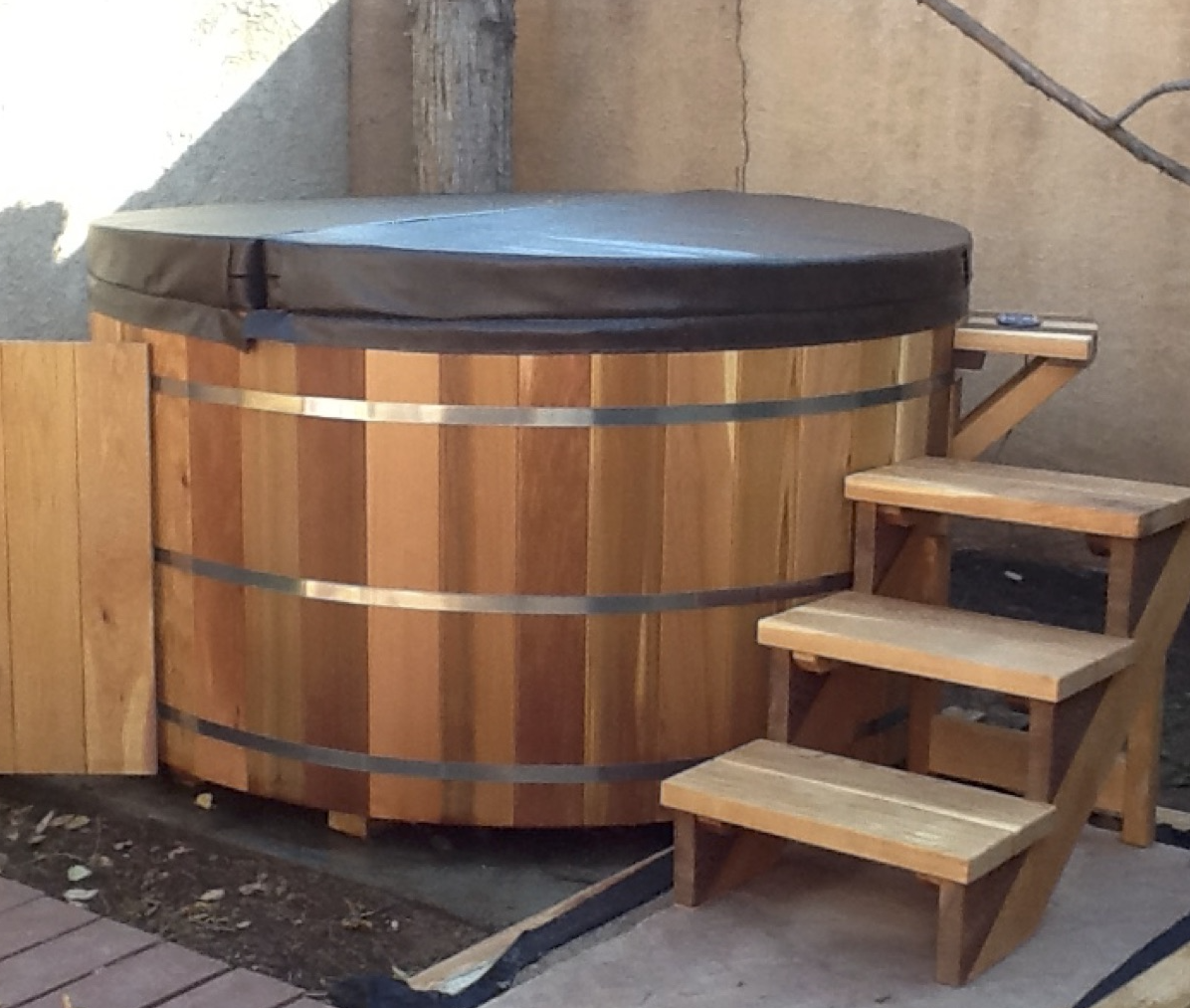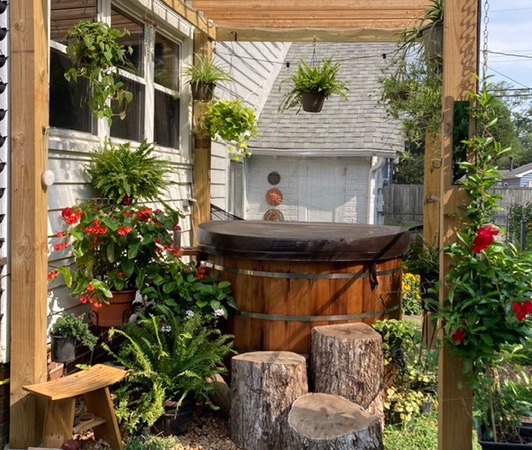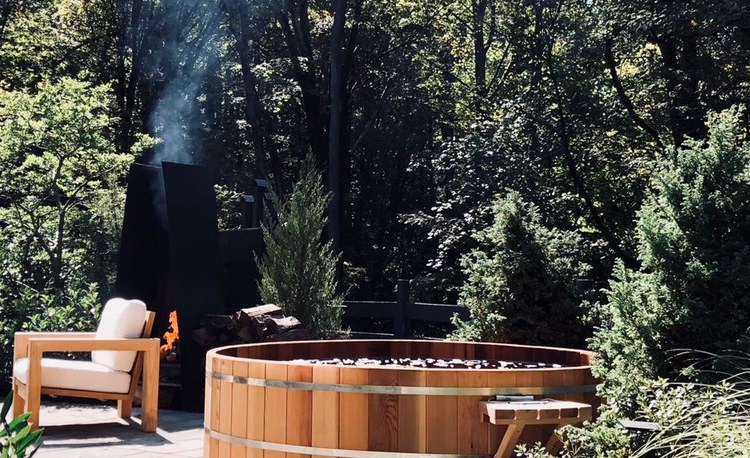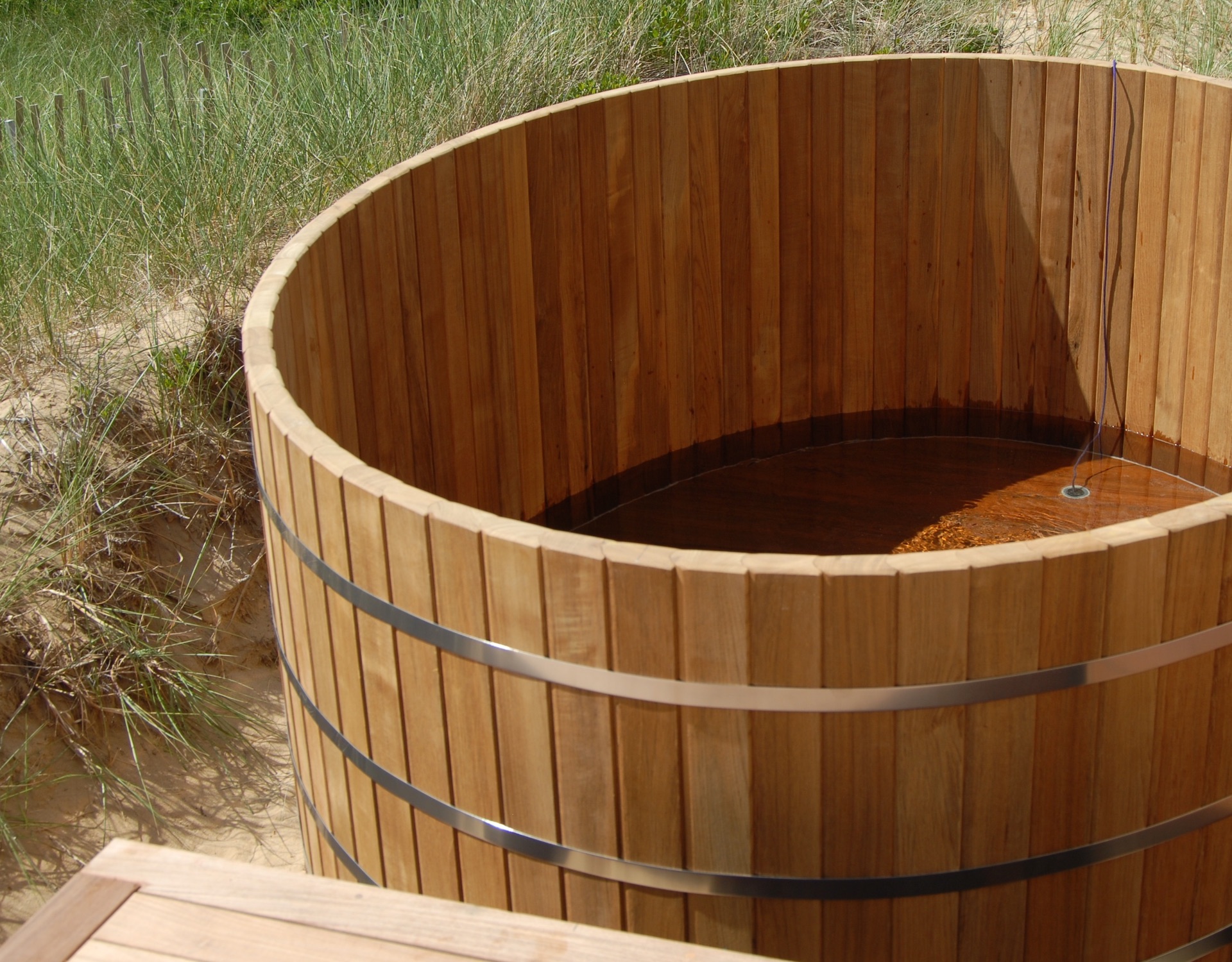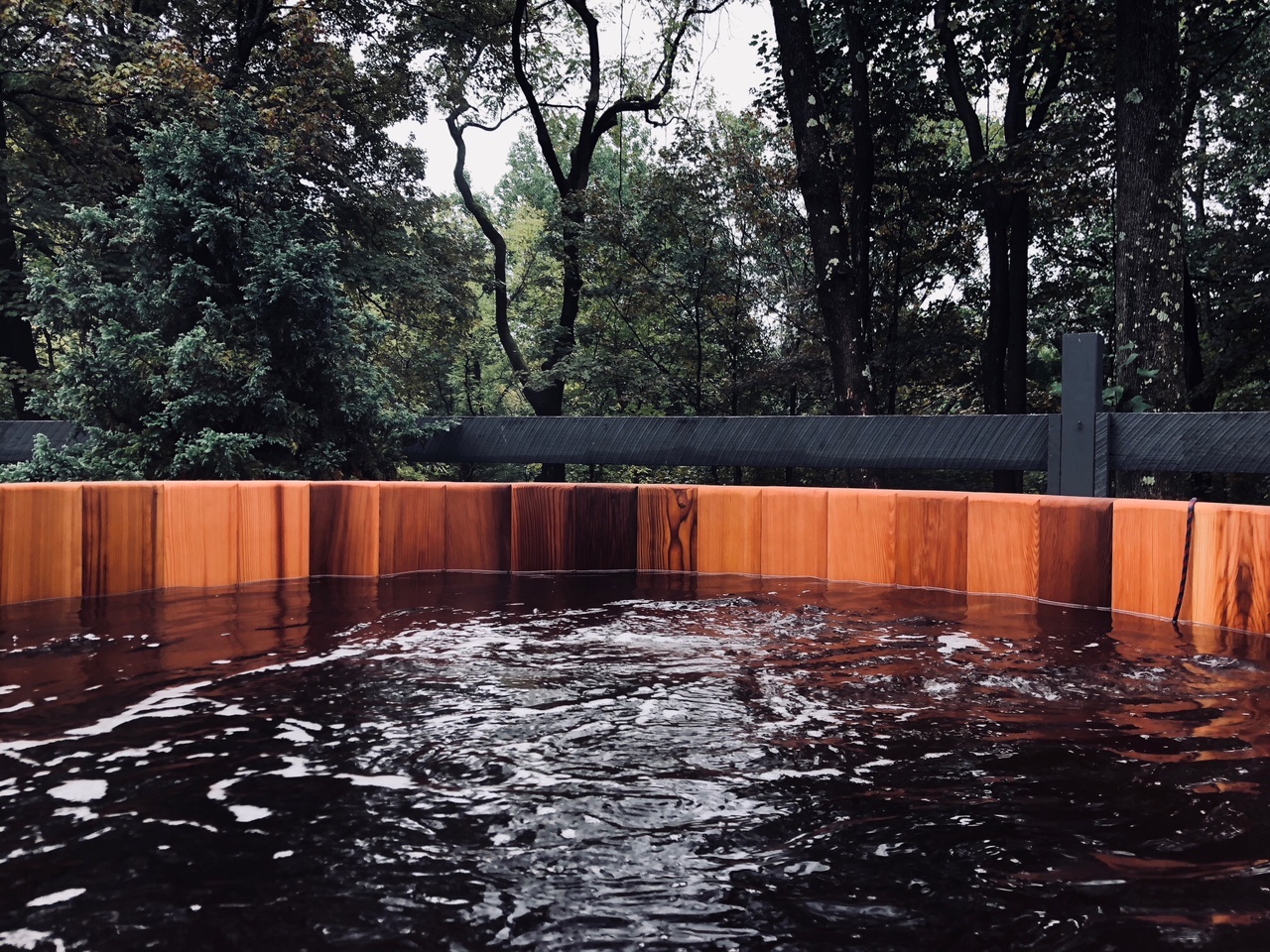Cedar Hot Tubs
Build Your Backyard Sanctuary
Experience the Magic of Cedar
A deep, hot soak is always a relaxing experience, but a cedar hot tub from Zen Bathworks takes it to a new level.
The sweet scent of cedar wafts amidst the steam. The texture of warm wood provides a welcome tactile respite from a world of metal and plastic and concrete.
Want the rustic simplicity of wood heat? We’ve got it. Prefer the convenience of automated heating and filtration? We’ve gotcha covered. Powerful massage jets? Can do.
Find your perfect soak in a cedar tub from Zen Bathworks.
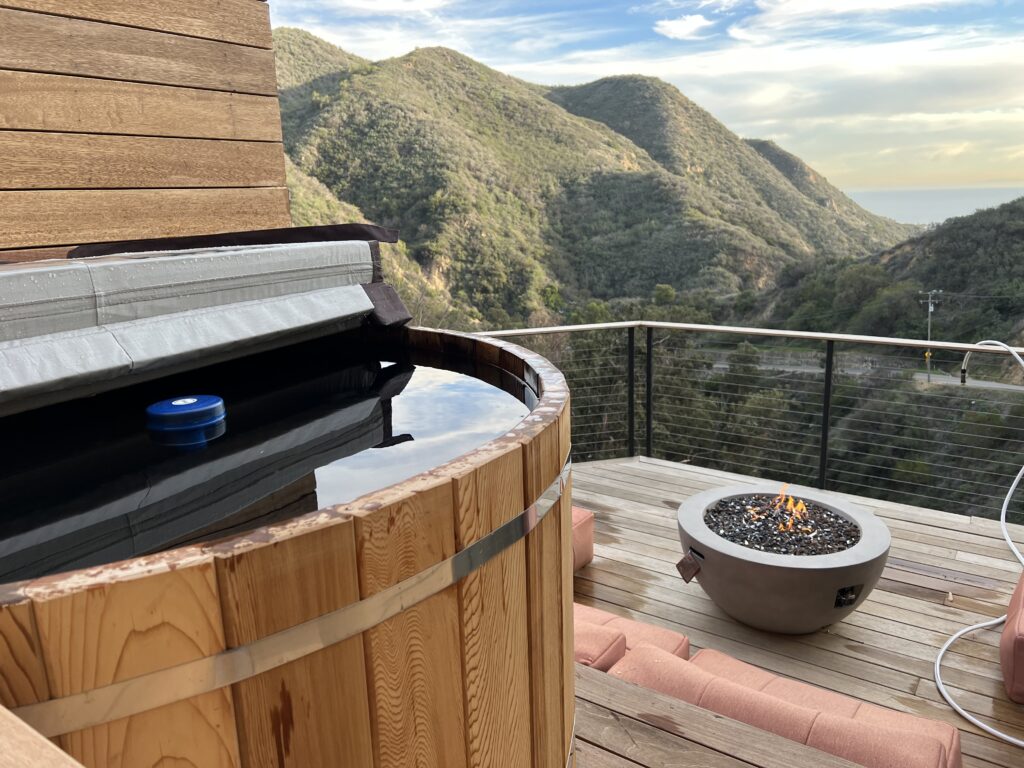

Exceptional Craftsmanship
Our commitment to quality governs every step of construction. That’s why each tub starts with premium, knot-free Western Red-Cedar heartwood. Red-Cedar’s qualities of beauty, workability, strength, natural rot-resistant oils, and sweet aroma make it the perfect material for a natural wooden tub. It is an abundant, well-managed sustainable resource.
We mill our staves with precise bead-and-cove edges that are easy to align and quick to seal. Our staves also feature a curved inside surface for increased comfort. We mill our staves to a full 1-5/8″ thickness for added strength, durability, and heat retention.
The tub is bound together by stainless steel bands, fastened, and tightened with sturdy aluminum fittings and rust-free stainless steel bolts.
where do i begin?
We know — there’s a lot to think about when you’re trying to choose a hot tub.
You want to be soaking in a new tub, not drowning in details!
We are here to help! We’ve designed this guide to help walk you through every option, so you can be confident that the tub you order is exactly the tub you need.
Feel free to contact us with questions or for additional information!
Already know what you want?
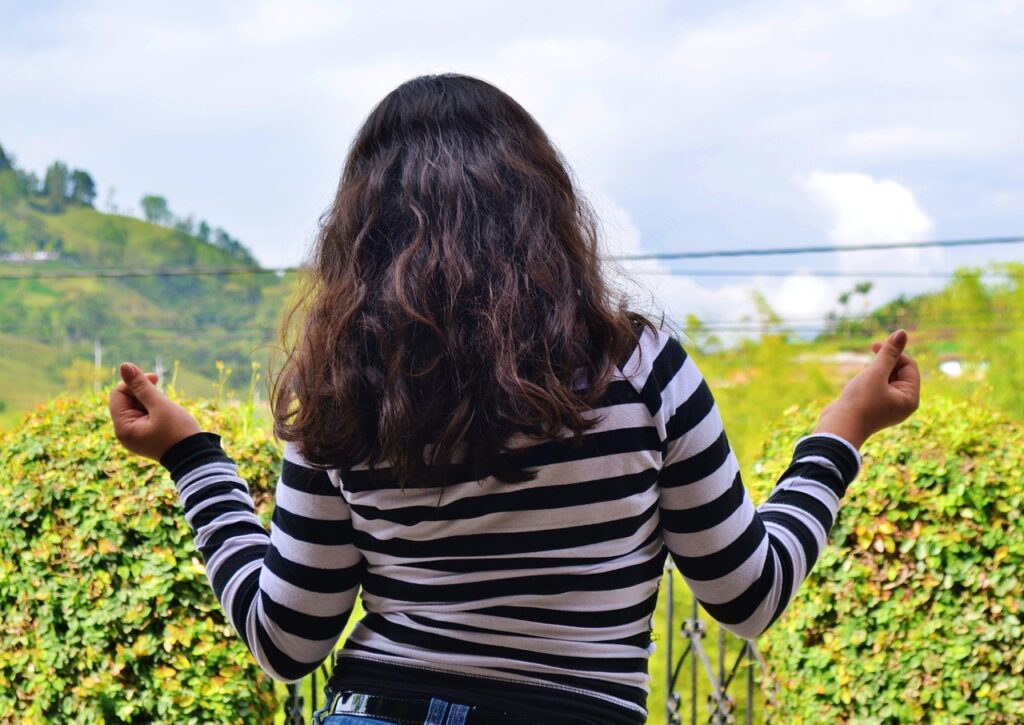
what size is right for me?
Zen Bathworks uniquely offers our tubs not only in ten standard sizes but also in four height choices within those sizes.
Forty choices might sound overwhelming, but don’t worry! We’re going to break it down into three easy questions.
Once we’ve answered those questions, you will be able to use our filtered gallery below to narrow down the choices to three of four tubs that fit your needs.
Ready to start?
Height: Want to Sit Up, or Kick Back?
As you can see in these cross-section views, all four of our tub heights offer shoulder-deep soaking, but the seating angle changes considerably.
The 29” height does not include benches at all, and sitting in the tub feels like being in a very deep bathtub. The other heights have proportionally taller benches, ending with the chair-like upright seating angle in the 48″ depth.
Shallower tubs hold less water, so they are a great option for water conservation. In our popular 6′ Round tub, choosing a 42″ instead of a 48″ saves nearly 100 gallons of water!
Less water also means that shallower tubs will use less energy to heat from room temperature.
Deeper tubs can hold more people for a given diameter since an upright seating position creates more legroom. Some people find the upright posture to be more comfortable.
Deeper tubs take longer and use more energy to heat when first filled, but the additional water mass helps them hold their heat for a long time. Once the tub is heated, keeping it hot costs about the same as a shallower tub.
The bather avatar shown is 5’ 7” (170 cm). The water level is shown 2” below the rim, but varies in usage as bathers enter the tub.
Capacity: How Many Bathers?
The images in the Cedar Hot Tub Sizes and Specs document and the filterable gallery below show about how many people can fit in each size of the tub. The bather models represent adults ranging from 4’ 11” to 6’ 4” in height.
Many of our tub sizes give a range of how many bathers can use the tub at once. The low end of the range is “spacious” seating for bathers who prefer enough room to spread out without touching toes or bumping elbows. The high end of the range is “cozy” seating for bathers who don’t mind occasionally rubbing shoulders with their neighbors.
We generally recommend sizing the tub for your normal, everyday use. It may be tempting to get a larger tub in anticipation of occasional hot tub guests, but then you will be committed to higher day-to-day operating costs for a capacity you may only use a few times per year.
- All
- 1 ppl.
- 2 ppl.
- 3 ppl.
- 4 ppl.
- 6 ppl.
- 7 ppl.
- 8 ppl.
- 9 ppl.
- 10 ppl.
- 12 ppl.
Tub Shape: What Fits Your Space?
Our hot tubs come in two shapes: round and ellipse. What’s the difference?
Mostly, it comes down to making the best use of your installation site. If space is no concern, Round tubs tend to have a little more legroom and are a little easier to plan around (recessed decks, for example). However, if your space is on the narrow side, the Ellipse shape is a great choice to get more capacity than you could from a Round tub.
For example, the 6′ Round and the 7′ Ellipse tubs shown are both great choices for six bathers, but the Ellipse is 12″ longer and 11″ narrower. If someone wanted to install a hot tub in an 8’-wide corridor between their house and a fence, that 11″ difference in width can make all the difference between a claustrophobic 20″ walkway and a comfortable 31″ path.
See Cedar Hot Tub Sizes and Specs for detailed dimensions.
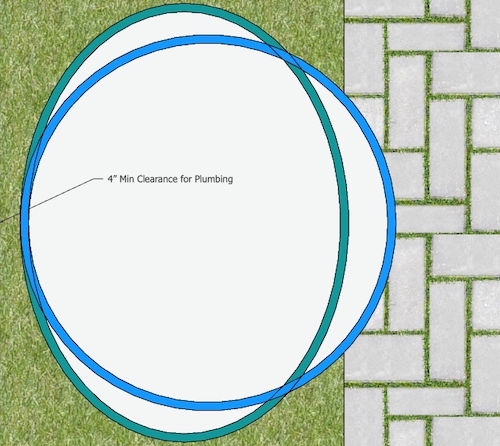
Heating Systems
We offer three different heat sources:
- Wood-fired
- Electric
- Gas (natural gas or propane)
Gas and Electric options include automated heating and filtration.
wood-fired
The Chofu wood-fired tub stove is a high-quality unit made from stainless steel. The firebox is fully wrapped by the heat-exchanging water jacket for efficient heat transfer. No pumps are needed — the movement of the heated water naturally flows the heated water into the tub and draws cooler water into the heater.
Pros: The ultimate in simplicity.
- No electricity needed
- Only two simple plumbing connections
- Thermal-cycling design allows more space than a snorkel stove
- Saves money on installation
- Very inexpensive fuel source
- Includes:
- Chofu woodstove
- Tub fittings and connecting plumbing
- (5) 2′ sections of stainless stovepipe
- Stovepipe cap
- Support bracket
Cons: No automation.
- No filtration means more frequent water changes
- Sanitation must be done with sodium dichlor granules
- No built-in freeze protection
- No option for massage jets
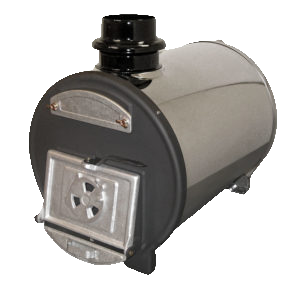
NOTE: the wood-fired stove can be purchased and used along with a gas or electric spa system, as a supplemental heat source.
Digital Spa System — your choice of Electric or Gas heat
- Digital Spa Pack control system
- Automatic temperature control
- Programmable filtration and sanitation cycles
- ClearBlue ionizer sanitation system included
- Ozone or AOP ready (?)
- Built-in overheat protection
- Built-in freeze protection
- Optional WiFi module
- Therapy pump and massage jet upgrades are available!
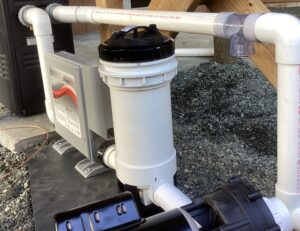
Our systems come with one of several heavy-duty water pump options. We select the pump that is most suitable for your system and installation. We offer a small, efficient circulation pump for systems that require only heating and filtration and powerful two-speed pumps for systems with massage jets.
The systems come with a two-year warranty. The spa pack (including the heater) and pump are mounted on a heavy-duty skid base.
Spa Pack with Electric Heat
Pros:
- Installation costs much lower than gas
- Smaller system footprint than gas
- Heating element is contained inside spa pack
- Can be installed under deck or within an enclosure
- Heater output sized to heat the cold tub overnight (6–12 hours in most climates)
Cons:
- Heating with electricity costs more than heating with gas over time
- May not provide enough heating for wintertime use in cold climates
- Slower heat-up time than gas; may not be adequate for large tubs in some climates
- Requires 240V electrical circuit
Spa Pack with Gas Heat (Natural Gas or Propane)
Pros:
- Very fast heat-up times
- Heating with gas often saves money over the long run (more true for larger tubs)
- Gas heaters can keep up with large tubs and cold climates
- Reduced electrical load allows system to be run on 120V circuit
- Propane and Natural Gas options available
- Low-NOx compliant heaters available
(low-NOx required by regulation in some areas)
Cons:
- Heater is much more expensive than electric heater
- Hard to hide with deck or enclosure
- Fuel lines add to installation costs
jet configuration
We offer three standard plumbing configurations with our spa systems. Hover or tap the images below for more information.
Not seeing what you need? Custom jet configurations are available. Contact us to learn more about options and pricing.
Quiet Soak
Is that your ideal soaking environment?
Our Quiet Soak system features a small, circulation-only pump, and a single water-return port. Enjoy all the convenience of automated temperature and filtration controls. Minimal plumbing makes it easy to display the beauty of the tub in any installation.
therapeutic hydrojets (qty 6)
Our Hydro-Jet package adds 6 powerful massage jets spaced around one half of the tub.
Open the valve for air bubbles!
Half of the tub's exterior is free of plumbing and can be proudly displayed. The plumbing can be hidden under a deck, in the corner of a fenceline, or within an enclosure.
therapeutic hydrojets (qty 12-14)
Our spa systems can run a second pump with 6-8 additional jets. These jets are spaced evenly around the other half of the tub, mirroring the primary jets.
Run all 12 jets at the same time, or run either bank of 6 independently.
Hiding the plumbing is most easily accomplished by fully recessing the tub into a deck.
Hot Tub Surrounds
Introduced in 2023, Zen Bathworks® Hot Tub Surrounds eliminate several former drawbacks. For customers who want massage jets, the tradeoff used to be the ugly white plumbing that came along with it. But not anymore. Now you’re free to wrap as many jets as you want, even around the entirety of the tub, knowing it will all be hidden with beautiful cedar!
Plus, now you can have LOTS of room to set your drinks, sunglasses, waterproof speakers, and anything else you need for your perfect soak. And there’s more! There is room inside the Surrounds to install the system* right next to the tub, maximizing pressure, minimizing heat loss and minimizing installation complexity. However if you prefer Surrounds still work great with remote system installations. The surrounds are 18″ deep. So a full surround around a round tub adds 36″ diameter.
Surrounds are very easily assembled on-site in sections from pre-built components. In fact they are designed to provide for virtually tool-less assembly and disassembly. And don’t worry, access to your system and tub is a breeze. Surrounds are designed in sections. Four for Half Surrounds and eight for Full Surrounds. Simply lift off the top of any section. Then lift up and away the side panel. And voila, you have access to any part of your system or tub without disassembling any other sections of the Surround. No screwdrivers. No fuss!
A Surround has the potential to eliminate the need for a deck. Not only will this save you money, but it will prevent your beautiful new tub from being hidden below a deck. Zen Bathworks® Surrounds were carefully and thoughtfully designed to complete your Cedar Hot Tub oasis. We’re confident you will love having one to go with your Zen Bathworks® Coopered Cedar Hot Tub.
*Gas heaters cannot be installed inside any enclosure made of combustible materials
Half Surround
Half Surround
The half-surround option provides plenty of room to hide 6 jets and install the system.
Full Surround
Full Surround
The full-surround option covers the entire tub, and features a built-in step for easier entry.
Hot Tub Sanitation
Correct water sanitation is critical for any hot tub for your health and safety, but for wood hot tubs it is also critical for the tub’s health and safety.
In the simplest possible terms, a complete water care program has three elements:
- A fast-acting sanitizer to get the water germ-free,
- A long-lasting residual to keep the water germ-free,
- An oxidizing shock breaks down contaminants into harmless particles
Chlorine is commonly used in water treatment because it can perform all three of these steps. Our wood-fired tubs have no filtration system, so they must be maintained with granulated sodium dichlor (the gentlest form of chlorine available) and frequent water changes.
Our spa systems allow our electric or gas-heated tubs to use significantly less chlorine. An ionizer provides a copper-silver-zinc ion residual. A tiny amount of dichlor added a few times per week acts as the sanitizer, while a larger dose of dichlor once or twice per month serves as the oxidizing shock. If you wish to reduce chlorine use even further, our sanitation system is compatible with any reputable aftermarket Ozonator, which replaces the oxidizing shock.
Insulated Hot Tub Cover
(included in the purchase price with every hot tub order)
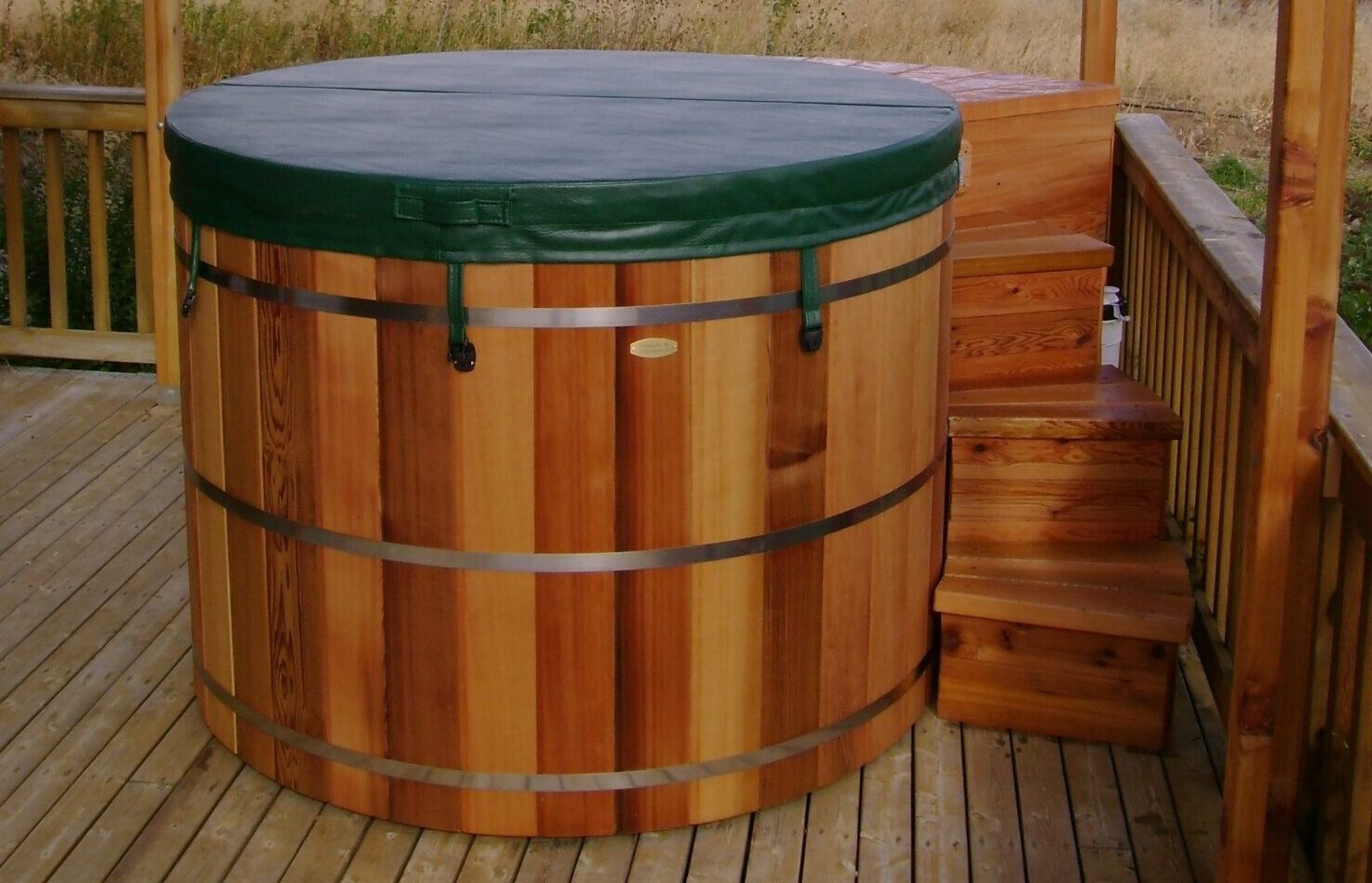
- - 1.5 lb. Aquatic Grade Core: 5">3" taper
- - R-22 energy rating
- - Dual 20ga Carbon Steel C-Channel Reinforcement
- - BlueMax™ Polymer - 6 Mil Core Moisture Barrier
- - Heavy-duty Locking Windstraps included
- - Built to ASTM 1346 standards
- - Reinforced hinge and handles
- - Skirt with gussets
- - Marine vinyl fabric
- - Made in the USA
- - Four-year warranty
- - Choice of 10 colors — See below!
cover color palette







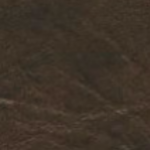

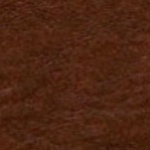
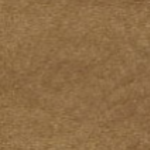
shipping configuration
We are pleased to provide free shipping to most US addresses! You have the option to receive your tub as a Kit or Pre-Assembled.
Note: With either option, the plumbing, system, and cover are NOT installed, and some items may ship separately.
Hover or tap the options below to learn more about the right option for you:
Kit
Kit
The wood tub portion of your hot tub system arrives unassembled in an enclosed crate.
This is an ideal option if you have a narrow passageway, such as a gate or doorway, through which the tub needs to travel between the curbside and your installation point.
Assembled
Assembled
The wood tub portion of your hot tub system arrives professionally assembled in an enclosed crate, with benches installed, tub exterior oiled, and the tub rim sanded & waxed. Our fee is a good value for professional assembly.
Pre-assembly is not available for 7’ Round or 8’ sizes unless offloading equipment is provided at your curbside delivery location. Shipping charges may apply.
Shop Cedar Hot Tubs
- All
4' Ellipse
1 person
4' Round
1-2 people
5' Ellipse
2 people
5' Round
2-4 people
6' Ellipse
2-4 people
6' Round
3-7 people
7' Ellipse
4-8 people
7' Round
6-9 people
8' Ellipse
6-9 people
8' Round
7-12 people
hot tub resource links
Use the links below to review and download cedar hot tub installation documents:
Hot Tub Assembly & Installation
> Assembly Installation & Maintenance Manual – Cedar Hot Tubs
> Hot Tub Assembly & Installation Key Fundamentals
> Instructional Insert – Cedar Hot Tubs ordered factory pre-assembled
Hot Tub Diagrams & Spec Sheets
Hot Tub System Product Manuals
Water Sanitation Summary:
All of our Cedar Hot Tubs require the use of sodium dichlor granules to keep your water safe and clean.
Our digital spa systems allow our electric or gas heated tubs to use significantly less chlorine. An ionizer provides a copper-silver-zinc ion residual. A tiny amount of dichlor added a few times per week acts as the sanitizer, while a larger dose of dichlor once or twice per month serves as the oxidizing shock. If you wish to reduce chlorine use even further, our sanitation system is compatible with any reputable aftermarket ozonator, which replaces the oxidizing shock.
Review & download full details here: Zen Bathworks Hot Tub Water Sanitation Guidelines
care & maintenance summary:
Caring for your Zen Bathworks Cedar Hot Tub is not difficult, but it must not be neglected.
Proper water care is the single most important maintenance item for your safety and to maximize the life of your tub.
The exterior surfaces of the tub should be regularly oiled to protect the wood and keep your tub looking good for years to come.
Use the links below to review and download cedar hot tub care & maintenance documents:
Hot Tub Care & Maintenance
Hot Tub System Product Manuals
Review & download our full cedar hot tub product warranty here: Zen Bathworks Hot Tub Product Warranty
Why wood tubs?
We are big fans of the amazing properties of wood. Did you know that scientific studies have found that touching wood reduces stress?
The captivating scents of red-cedar and cypress wood aren't their only amazing superpower - the same oils and resins responsible for the inviting aroma are chock full of antibacterial and antifungal molecules that help prevent mildew and decay, allowing us to create soaking tubs that last for decades.
Maybe we're a little biased, but we think plastic bathtubs are overrated. We believe in combining the best of old traditions and new technology; in making practical, modern products out of natural, sustainable materials like wood in order to connect with human history and the natural world. Doesn't that sound refreshing? Take the plunge - make handcrafted wood a part of your life.
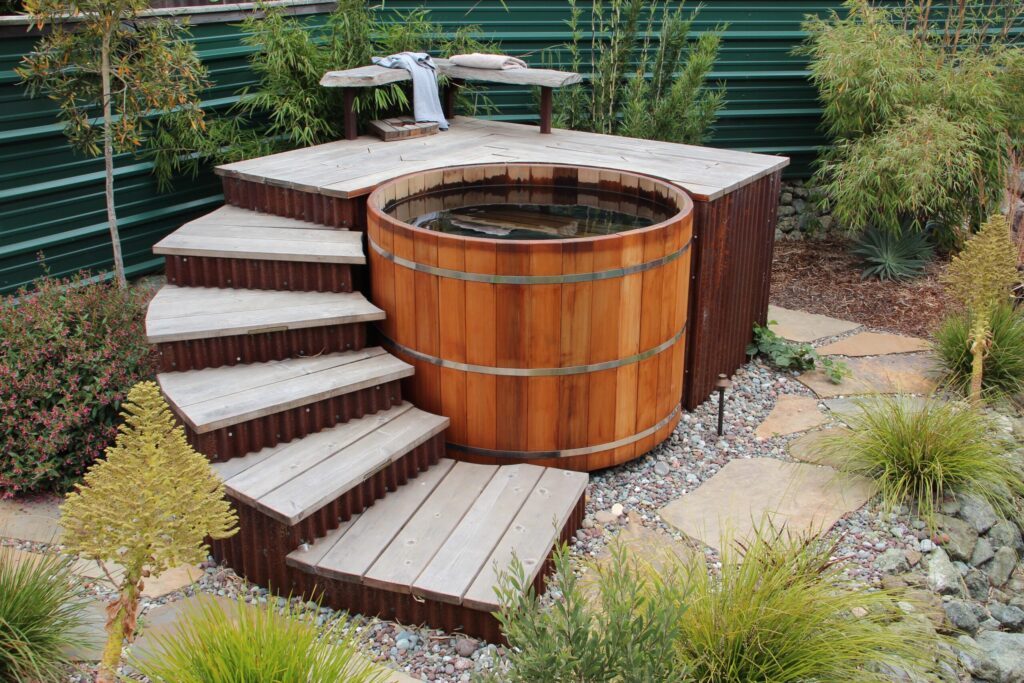
Hot Tub F.A.Q.
Find answers to commonly asked questions below
Natural Beauty: The breathtaking beauty of handcrafted natural wood is one of the prime advantages. Relax in harmony with nature surrounded by the enticing natural aroma of the cedar tree.
Deep soaking with freedom of movement: Our tubs are designed to be deep — with the water coming right up to your shoulders — giving you complete immersion and a feeling of buoyancy. There is ample water to move around in, unlike common plastic hot tubs that feel about as spacious as an airplane cockpit. Not with Zen Bathworks hot tubs. Our cedar hot tubs are deep, hot, clean, natural, simple, and amazing!
Health Benefits: Deep soaking in steaming water has long been proven to stimulate circulation, reduce stress, relax sore muscles, help with insomnia, and aid with common joint pain such as arthritis.
Convenience and Simplicity: Your very own private relaxation refuge in your backyard. A relaxation sanctuary that’s never closed or booked, but always a few steps away and ready whenever you are!
Family Fun: Socialize and relax with your family in the outdoors — soaking in a cedar hot tub is good clean fun!
Stress Reduction: Melt away the troubles of your day as you do something soothing for yourself.
On-site assembly: By choosing the “kit” tub configuration your tub can be placed just about anywhere, avoiding problems bringing your new hot tub to sites with access restrictions. All pieces can easily be carried through your home to your backyard if necessary, compared to common plastic tubs that often require a crane to install. No cranes and no broken backs are needed for Zen Bathworks Cedar Hot Tubs!
Flexible Installation Layout: The “systems” of our gas and electric heated hot tubs are comprised of a controller system with topside keypad, pump(s), sanitation system(s) (e.g. ionizer, Ozonator, filter, etc.), heater(s), etc. These systems can easily be placed up to 50′ away from the tub if this is more suitable for your space and desires. With some prior planning, the systems can be distanced even further. While the pumps are surprisingly quiet, this affords you the opportunity to completely isolate your tub away from the system noise, or place your hot tub near a bedroom window, but the system somewhere more ideal. Common plastic hot tubs do not offer this flexibility. However, you still have the option to place the system near your Zen Bathworks tub if you desire, which is a common choice and affords installation simplicity. Whichever situation you find yourself in, consider our corresponding cedar system and plumbing enclosures for a complete cedar beauty look.
Handmade in Alaska: Our tubs are handmade one at a time by skilled crafters in Haines Alaska, USA — not mass-produced.
Outdoor Activity: You will find yourself immersed in the sights and sounds of nature year-round, from the comfort of your warm and quiet outdoor tub. Experience more of nature with our cedar hot tubs!
Rustic Luxury: Our customers appreciate the unique aesthetic beauty the wood and the simple tub design bring to their relaxation sanctuary space. Coopered wood tubs have been used for many hundreds of years for their simple design and natural primary material of construction. However, our valued customers and partner installers continually comment about how luxuriously beautiful and high-quality Zen Bathworks cedar hot tubs are in particular, holding them uniquely distinct even when compared to competing cedar tubs.
These terms are often mistakenly used interchangeably. The primary definition of the word spa is an establishment such as a destination or resort spa. However, hot tubs are often referred to as spas for some reason.
Jacuzzi® is a registered brand name of multiple products, though it is often used incorrectly as a generic term referring to hot tubs.
The term we feel is correct for our cedar coopered-design tubs with heating/sanitation systems is “hot tubs”. We use the term “Ofuro” to describe our Japanese-inspired soaking bathtubs.
We recommend sizing your tub for your normal family use, not for the occasional large group or party. The hot tub product pages have diagrams and specifications that show the ranges of how many people fit in each size tub, from a “spacious” fit to a “cozy” fit. Click here to explore hot tub capacity by shape and size.
We do offer custom sizes, however, we feature the most extensive standard size lineup of cedar hot tubs with five sizes, two shapes, and four heights which makes a total of 40 unique size choices. So the odds are that you’ll find a standard size perfect for you. But, if not, please contact us!
We also offer customizations such as alternate woods of Hinoki or Teak. Also, if you have desires for other customizations, feel free to contact us about these. We can help you with design. These services are subject to lead time extensions, especially during our busy season, so start planning with us early. Contact Us!
Just like a wooden boat or wine barrel, the wood swells in the presence of water to form a water-tight seal. However, the correct materials and craftsmanship must be included for this to occur. At Zen Bathworks, we use high-quality clear (i.e. knot-free) cedar, and our tubs are made with care and precision.
The answer depends on your situation. That is why we offer three types of heating systems: gas-heated systems (your choice of propane or natural), electric-heated systems, and wood heaters.
- Gas systems are the most powerful and therefore afford the fastest heat-up rates and lower cost of operation than electric heat.
- Electric systems have slightly simpler and lower costs of installation.
- Wood heaters are a great choice for off-grid installations or as a supplemental heating system.
- Note that Gas and Electric, with integrated pumps, offer digital programmable thermostatic control and sanitation automation, while the wood-fired heaters move water through the thermosiphon phenomenon rather than a pump and thus do not have built-in thermostat or sanitation automation, but also do not require any electrical power.
- Wondering if you can have more than just one type? Yes! Opting for two or three of the above is possible.
Still not sure? Find out more about heaters.
Some will like it cooler (98°–101°F) and others will like it hot (102°–104°). Hot tub systems have a manufacturer’s imposed maximum limit of 104 degrees Fahrenheit because according to medical experts, temperatures higher than 104°F can be hazardous to human health. Children should use a tub that is no hotter than 100 degrees. Pregnant women are typically advised by their medical providers to avoid hot tubs. Those with adverse health conditions, questions, or concerns should consult their medical provider. As for how cool the water can be, the gas and electric systems’ thermostat can be set as low as 50°.
When it comes to deciding what the optimal temperature management is, it depends a lot on your usage frequency. It’s very possible that turning down the hot tub too much and too often could end up increasing the energy costs rather than decreasing them. It’s similar to your household heating system — if you drastically turn down your heat prior to leaving for a short trip of say two days, when you return your furnace could spend most of a day heating back up and in the end, it could have been more efficient to only turn your heat down slightly. But for a long trip of say two weeks or more, these inflection points and tradeoffs may lead to the opposite result where drastically decreasing the temperature does lead to an energy savings.
The other thing to consider with hot tub temperature management, especially if you don’t utilize the economy mode and/or WiFi capabilities to automate, is how long you will have to wait for it to heat back up to use the tub.
So, it varies based on your tub size, installation, climate, and usage habits. However, for the most part, tub owners use their tubs twice a week or more and hold the temperature in the high 80s or low 90s.
Heat rate depends on factors such as tub size, outdoor temperature, and heater size. The following numbers give a range for each type of heater:
- Electric heaters: 4–12 °F per hour
- Gas heaters: 10–40 °F per hour
- Wood heaters: 5–20 °F per hour
An important note about heat rate: It is easy to get swept up in the heat rate, but note that with gas and electric heat systems, you will not frequently be waiting for your tub to heat up. This is because they are thermostatically controlled and also because there are features such as economy mode and WiFi control that allow you to plan and automate your hot tub temperature management around your hot tubbing schedule. The only time you may have to wait for your tub to heat up is after a water change, but even in that instance connecting your garden hose to your home’s water heating system when filling the tub, could potentially help you to shorten the wait time, if possible, and if necessary. The point is, don’t worry too much about having a high heat rate unless you will be using your tub infrequently, erratically, with little notice, and without WiFi connectivity. All of these factors coexisting is uncommon.
NEW FOR MID-2023, for better circulation, a more clean-looking installation, and better draining, we have moved the suctions from the lower walls to the floors of our tubs. Therefore the drain is a 2″ tee with a valve within the suction line.
Each of our tubs before then included a floor drain featuring an interior tapered plug with rip cord floor drain. In the drain, assembly fittings to bring a 1″ drain line to the tub’s edge were included.
With either drain type, you can plumb additional lines if you wish, or with adapter fittings, you can attach a garden hose and dispose of the water into your landscape or other ideal location. If you follow our recommended water sanitation procedure, the water is safe to use for landscape plants, but we don’t recommend using it for your vegetable garden.
Other cedar tub manufacturers do not include the ability to drain and rinse the tub out fully empty. However, at Zen Bathworks, we decided that wasn’t good enough and have remained committed to making sure Zen Bathworks hot tubs will drain out fully and offer an easy way to rinse dirt and sediment out!
Yes, cool and cold weather were made for hot tubbing! Cedar is a good natural insulator — and our tubs have many years of service everywhere from Alaska to Maine.
It is crucial to have a good thermal cover, which is why we provide premium hot tub covers with an insulation rating (R-value) of up to 22. Our heater systems are thermostatically controlled and therefore automatically keep your water temperature above freezing. Our systems have freeze protection programming that will run the pump constantly if something goes wrong with your heater (e.g. you run out of propane). You will want to consider power outages if you are away from your tub for prolonged periods of time. The WiFi option is helpful in this situation as it will help you monitor at least for power/WiFi outages, or typically the temperature of your hot tub.
If you expect to be away or don’t intend to use your tub during freezing temperatures the tub can be drained and shut off. Refer to your owner’s manual for details on how to drain and winterize your tub.
The exterior Chofu wood-fired heater has many advantages over submerged inside-the-tub heaters such as Snorkel®.
No occupancy loss: Inside heaters can take up as much as 1/3 of the interior space of your tub! But the Chofu does not take up any room inside the tub. This means you have 1/3 more space in the same tub — or you can get a smaller tub and have the same amount of space.
Less heat loss: Inside heaters prevent the use of a full coverage insulated top so heat is lost. The Chofu heated hot tub can use a full coverage thermal blanket and cover drastically reducing heat loss.
Less water level restriction: Water level should be kept over the tube of a snorkel heater to prevent warping the metal box — an approach that is prone to problems and wastes water. With the Chofu, the water level can be set much lower to eliminate wasted overflow.
No mess in the hot tub: Unlike interior wood-fired heaters the Chofu introduces no wood debris or ash into the water — helping to keep things nice and clean.
There are three factors that affect the cost to operate a tub, all of which vary by individual and/or region:
- Size of the tub
- Climate
- Cost of energy or fuel
- Installation of the tub (e.g. the distance the system is displaced from the tub if the lines are insulated, etc.)
Our electric and gas-heated tubs run between $1.50 and $3.50 per day to keep hot. Our simple Chofu wood heater is even more economical to operate.
Zen Bathworks hot tubs are professionally packaged in fully enclosed robust wooden crates (no chintzy cardboard here!) for safe transport to your curbside. Your tub is shipped by common carrier LTL trucking service, with liftgate service (if necessary). We ship to most US and Canadian addresses for FREE.
There are some exceptions to this rule such as addresses with access restrictions (e.g. tight turns, low trees, steep hills, etc.), Hawaii, or Alaska. Our rates to HI and AK are low (roughly $400–$1500) — please contact us for a quote to your specific address.
Click here to view our Shipping Policies for additional details.
Up-to-date standard lead times are displayed on the Hot Tub product pages in the product description. Sometimes, due to popular demand, we are forced to lengthen our lead times, however, we work hard through production and inventory management to prevent this. Our lead times are typically at the best available which is 3–6 weeks from order to curbside delivery within the continental US and Canada. From our location in southeast Alaska, 3–4 of these weeks are ocean and ground in-transit time.
We are eagerly awaiting the opportunity to bring your cedar hot tub soaking dreams to life as soon as possible!
Our tubs are designed to be easily assembled by the owner or by the owner’s contractor. Each tub comes with a detailed step-by-step illustrated instruction manual.
Typical tub assembly time is about 3–5 hours (not including site preparation or system installation) and requires minimal tools (a couple of wrenches, a level, a rubber mallet, etc).
The gas or electric heating system will take 3–5 hours to install (not including main electrical and gas services). The system does require some electrical and plumbing skills, so you may want to seek help from a plumber and electrician for this part. Either way, we strongly recommend you have the main electrical and gas service connections made by a qualified professional. The wood heater is quite simple to install and should only take about an hour.
If you are not comfortable setting up your hot tub and system, you can hire a general contractor, handyman, plumber, and/or electrician to do all of it or parts of it. They may be hesitant due to unfamiliarity with cedar hot tubs. However, they should not hesitate. There is nothing uniquely complicated about cedar hot tubs for qualified professionals in these lines of work. Be sure to have them review the detailed documents we’ve made available online on our Resource Tool Box page or contained in the printed Info Packet you receive along with your tub. Let them know that Zen Bathworks offers technical installation support by video chat, phone, and/or email!
Zen Bathworks does offer a factory pre-assembly option for the wood tub portion only. When checking out or confirming your order via email, select this option and we will professionally assemble and oil the tub and install the benches. Note that you will not want to choose this option if you have a narrow passageway, such as a doorway that the tub needs to pass through to get from curbside to the install site.
Also, note that this option is not available for the very largest sizes (7′ and 8′ Round and 8′ Elliptical) unless you have a commercial address to receive and offload the shipment to (with a forklift). This is because these larger tubs are too large for the trucking companies’ lift gates.
Because Zen Bathworks is a small family-owned company with one location in southeast Alaska, at this time we are not able to offer on-site installation. We do know of installers in the Los Angeles and in the Bay Area California regions that are experienced with Zen Bathworks hot tubs. If you are in those regions and looking for an installer, please let us know.
If you require assistance assembling and installing your hot tub system, you will need to locate and hire your own trade professionals to assist you. Be sure to have them review the detailed documents we’ve made available online on our Resource Tool Box page and tell them Zen Bathworks offers technical installation support by video chat, phone, and/or email.
Also, if you have a great experience with an installer, we would love to hear about them so that we can pass along their information to other customers. Or perhaps you are a trade professional interested in receiving our referrals from clients looking to have a Zen Bathworks tub installed? In either case, please contact us!
Here are a few things to keep in mind when selecting your installation location(s).
Generally outdoors is best. An indoor location will require careful planning to provide humidity control and splash and tub drainage in the enclosing room.
For outdoor installations, consider the following:
- The closer your tub is to your house, the more prone you might be to use it.
- Closer proximity to power and gas sources (as applicable) is a cost-saving advantage.
- The system will generally run automatically for at least a minute, twice an hour. While the pumps are very quiet, especially on low speed, light sleepers may not want the system to end up right next to their bedroom window, for example.
- Be mindful of watershed during rainstorms from adjacent structures and how they will impact the hot tub.
- If you’re in a snowy area, consider how snowfall, snow shed, and snow clearing will impact prospective installation spots.
- Privacy and atmosphere are important. You will likely want to set your hot tub in a secluded spot away from it all.
Indoors is a feasible but tricky place for a hot tub because of the large amount of water vapor they release into the air. You will need a plan to provide humidity control as well as tub splash and drainage water control. Certain types of rooms, such as sunrooms and enclosed porches, can be made into great hot tub rooms with a little less hassle than a traditional room type. Consult your General Contractor for more details.
Our tubs range in size and weight. You can find full details on approximate water capacity and weight on the last page of the Cedar Hot Tub Sizes and Specs document.
The three most common sites for a wooden hot tub are on a patio, on a deck, or on the ground.
We recommend a concrete pad patio to install the tub onto, if possible. These make installations easier because they are strong, level, and smooth.
Deck installations are also a great choice. Be sure to have a professional check that it is engineered to handle the weight. A tub full of water is very heavy — refer to the tub specifications for the actual weight of each of our tubs. The filled weight for an average tub is over 4000 lbs.
A modification to this approach is to place it on the ground and recess it in a deck. If you have a pre-existing deck, this can be a good choice that adds an entry into your tub as a function of your deck. Keep in mind, the tub still needs to be supported in a proper way. This approach sacrifices the visibility of the beautiful tub, however, it does add sun protection for it.
The hot tub can also be placed on the ground: The site should be level and compact. Use fine gravel or coarse sand to prepare a well-drained, level, and stable soil base.
Click here to view our hot tub installation document for more information.
Cedar hot tubs are easiest to install above ground because the tubs cannot be soil backfilled. Below-ground installations will require concrete retaining walls. If you wish to provide retaining walls, then yes, a Zen Bathworks Wooden Hot Tub can be installed below ground.
The ACC brand gas systems require a 120V, 20A electrical circuit with GFCI. The ACC brand electric heated systems require a 240V, 50A electrical circuit with GFCI.
The gas heater will consume approximately one gallon of propane for each hour it runs. Keep in mind your heater doesn’t run 24/7 just because you have your system on. Like the furnace in your home, it has a thermostat and turns on intermittently to maintain the water temperature you have the system set to. Obviously the higher you have your thermostat set to, the colder it is outside, and the less the water is insulated from heat loss, the more time your heater will spend running.
We recommend having at least a 120-gallon (aka 420 lb) propane tank. These tanks resemble an upright barrel and are about 4″6″ tall and 30″ in diameter. When full these tanks hold 96 gallons of fuel and typically will supply a hot tub’s need for at least a month. Keep in mind this can vary a lot and in extreme cases, this tank might be inadequate. However, for most scenarios, this tank size is adequate. Bigger tanks will simply give you more peace of mind and more time in between fillings.
Overall the 11kW uses the same amount of electrical energy. It just has a heating rate that is twice as fast, therefore it will run half as long and in the end use the same amount of electricity as the 5.5kW heater would have.
It is common for our customers who use their hot tubs relatively frequently to keep their water temperature setting pretty warm. And in such cases, the speed at which the system will heat up the tub is not all that important. Also, with the addition of the optional WiFi remote module, you can turn up your hot tub from anywhere in the world if you have a smartphone or tablet and a data connection! This makes it less imperative to have a fast heat-up rate as well. However, the larger the heater you have, the more flexibility you have. You can still set it however you want and if you find yourself in a situation requiring a faster heat-up time, you’ll have the heater to do it.
Keep in mind, gas heaters far outperform electrical in both efficiency and heat-up rate capabilities.
Hot tub pumps are not very loud, especially on low speed. The single-speed pump and the dual-speed pumps while on low speed are way under 50 dB when measured just a few feet away. The noise level only exceeds 50 dB if the reading is taken less than 12 inches from the running pump. On high speed, the two-speed pumps’ noise levels are quiet enough that even if placed near the tub, they do not inhibit conversation between the tub occupants or cause the need to yell.
In short, it can take up to around two weeks for the tub to fully seal. In general, when you first start filling your new tub, you may experience a range of leaking levels, from no leaks to several spots with running leaks and several more spots with drips. If you followed the assembly procedure correctly, there’s no cause for panic. The biggest changes will occur during the first two days of the tub being full of water and kept full of water. After two days, you should not have any running leaks, only drips.
Click here to view our hot tub assembly manual with additional details under Section 11: Adding Water. For troubleshooting purposes, please refer to our Hot Tub Leak Troubleshooting Guide.
No. Zen Bathworks Cedar Hot Tubs have wood-on-wood interfaces that seal because as the wood absorbs the water, the compression retention bands channel the forces on the staves (wall pieces) and floor toward each other to create water-tight seals.
As for the fittings, gaskets are supplied to seal their interfaces with the wood of the tub. Therefore, no sealants are needed besides the PVC primer and cement used to join the plumbing fittings and piping.
Our Cedar Hot Tubs are easy to maintain.
Tub Exterior: To keep your cedar tub looking glorious, we recommend applying an occasional coat of teak oil on the exterior surface and rim. After the oil on the rim is cured, apply furniture wax. We recommend liquid paste-type wax. This should be repeated as necessary and is usually between one and four times per year, depending on how much the tub is exposed to direct sunlight. If the cedar looks slightly dry rather than slick and shiny, that’s a good sign it’s time to oil and wax. It’s a simple and enjoyable hand application process. Knit material rags (T-shirt material) are recommended.
Tub Interior: No finishing products should be applied to the interior of the tub. Clean the inside with mild soapy water and a soft-medium brush between water changes.
Water Sanitation: Follow the water treatment steps on our Water Sanitation Guidelines to keep your tub water clean and safe. This entails regular filter cleanings/rotations (approx every two weeks), PH checking, and chlorine administration up to once per tub usage, as directed. You can get a more complete summary of the process to keep your hot tub water clean in our next FAQ.
Our recommended hot tub water sanitation method involves three things working together:
- A filter
- A built-in ozonator and/or ionizer
- Limited use of a special type of chlorine
When you purchase a tub kit from us we include a “starter kit” that has what you need to get off to a good start. The details are included in these instructions.
Here’s a summary: Follow the water treatment steps in our Water Sanitation Guidelines to keep your tub water clean and safe. As you will see, this entails regular filter cleanings/rotations (approx every two weeks), PH checking, and chlorine administration up to once per tub usage, as directed. Also if you have the ionizer you will need to monitor copper concentrations. During the first year, your cedar will release tannins into the water. Tannins offer healthful antioxidants but also react with the chlorine. Therefore during the first year, you’ll add a bit more chlorine and change the water a bit more often. After this process is complete, which typically takes about six months, you will be able to change water much less frequently — every 30–40 hot tub uses, or every four months, whichever happens first.
While there are some measures to reduce the need for sanitation chemicals to almost nothing, some amount of sanitizing agent (e.g. chlorine) is necessary. A sanitizing agent plays an important role in every certified hot tub sanitation system. Even saltwater pools use electrical currents to turn the salt into chlorine. Many of the sanitation products that claim to eliminate chlorine expose you to other chemicals that are equally hazardous (if not more) and that are less effective.
The ozone, ion, and AOP systems we offer reduce the amount of chlorine needed to the lowest levels possible with current technology. Good usage habits such as showering before soaking also reduce the need for chemicals.
The recommended doses are detailed in our Water Sanitation Guidelines. For reference, our recommended chlorine dose for one of our bestselling models (6′ Round with ionizer) is merely one tablespoon at a time during break-in, dropping to ¼ tablespoon after the tannins have been released from the wood. These levels are so low that if you hadn’t put it in yourself, you’d never know it was there. You will not notice a persistent odor or feel any effects when using the tub.
Chlorine can be bad for cedar if you add too much or use the wrong kind. Dichlor is the gentlest chlorine product available, and no other form of chlorine should be used on wood tubs. It is possible to damage your tub with dichlor by ignoring the recommended amounts, but when used correctly, the small amounts of dichlor will not harm your tub, or you.
The recommended doses are detailed in our Water Sanitation Guidelines. For reference, our recommended chlorine dose for one of our bestselling models (6′ Round with ionizer) is merely one tablespoon at a time during break-in, dropping to ¼ tablespoon after the tannins have been released from the wood. These levels are so low that if you hadn’t put it in yourself, you’d never know it was there. You will not notice a persistent odor or feel any effects when using the tub.
Some people use bromine for cedar tubs instead of chlorine, thinking it will be better for the tub. It is true that bromine is gentler on wood than some forms of chlorine, but it is still about as harsh as dichlor-type chlorine. We prefer dichlor for one big reason though: excess dichlor evaporates, and excess bromine soaks into the wood. We believe that over time, a cedar tub maintained correctly with dichlor will outlast a tub sanitized with bromine.
Consult a local pest control expert for the best advice, but you can try using deterrents such as diatomaceous earth or copper.
If you need to move your Zen Bathworks Hot Tub, it is best to move it assembled. Although they may not look like it, empty cedar hot tubs can be lifted by three or four strong individuals. You may wonder if you can turn it on its side and roll it. If the bands are tight, this is possible, but probably not practical unless for very short distances. This is because you will likely mar the outside of the tub. Cedar is soft so it dents and scratches easily.
If you must disassemble it, let it dry for at least two weeks before disassembling. When reassembling, all staves must go back in original order and as much as possible, and back in the same orientation with relationship to the floor. It is not unlikely that a stave or two will break during disassembly or reassembly. If this occurs, contact us and we can send you measuring instructions so that we can make you a new stave.
Zen Bathworks Cedar Hot Tubs can realistically offer an average of 20 years of service when properly installed and maintained.
Our cedar hot tubs and accompanying systems have a limited warranty for a full two years against defects in material or workmanship. Our Zen Bathworks insulated Hot Tub Covers have a limited four-year warranty. Click here to view our hot tub product warranty.
We are a small family-owned company committed to customer satisfaction. We realize our products are investments. We work hard and tirelessly exercise all feasible options to keep you enjoying your hot tub for years and years to come. Contact Zen Bathworks with any questions today!
